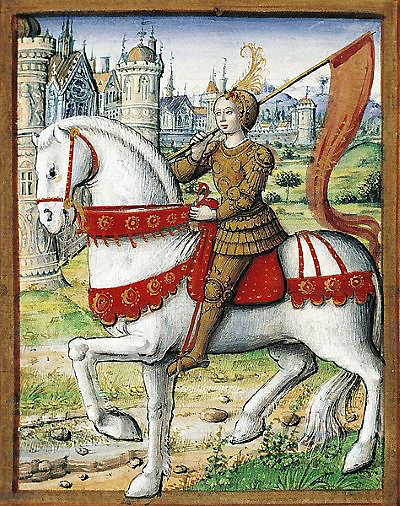IN MANY CULTURES WHITE IS SACRED AND HEROES ARE ASSOCIATED WITH WHITE HORSES
Mohammed Ascends to Heaven, Turkish, toward 1540 / zoom
 |
Detail of illuminated manuscript, Poitiers, 12th century, British Library The Apocalypse: "Behold a white horse: And he that sat on him had a bow; and a crown was given unto him: And he went forth conquering." |
 |
Washington Crosses the Delaware by Emanuel Leutze, 1851 / zoom |
Reproductions adorn American classrooms.
Fifteenth-century miniature / zoom
Saint George and the Dragon by Johann Kônig, announcement at Zurich auction, 2024
At Saint James of Compostela, a Spanish king fights the Moors (16th century).
Henri IV at the Battle of Arques, attributed to Jacob Bunel, early 17th century / zoom
Louis XIV Receives the Keys to Strasbourg on October 23 1681 by Constantyn Francken, toward 1700 / zoom
Louis XIV prepares an entry.
Maurice Leloir in Richelieu by T. Cahu, 1901 / "History of City Hall" by J. Beaujoint,1883 (in French)
Richelieu and Louis XIII after they crush the Protestants / Henri III flees after the Day of Barricades
 |
The leader of the Descente from la Courtille, 1842 |
Marginals adopt the same symbolism.
# # #
Already shown (usually scroll down)
A crusading king arriving in Constantinople painted in the mid-15th century, as well as Charles VII entering Rouen in 1449, François I's royal entry of 1540, a king presiding over an execution in a manuscript of the end of the 15th century and in an altarpiece of 1611, Rubens on Marie de Médicis, 1624, Louis XIV at the Crossing of the Rhine, n.d. but after 1672, and Louis XIV's royal entry in an illustration of 1931.
# # #
The hero's horse is white even in defeat, if the public backs his cause:
- The chief of the Gauls submits to Caesar with dignity, in a schoolbook for French children after defeat by Prussia:
Sixteenth-century ceramic, Blois château museum / Carolyn Ristau
Street-fair painting
Chadaev, hero of the Soviet civil war
Le cheval, animal politique by Jean-Louis Gouraud, ed. Fabre, 2009 |
Nicolas Sarkozy, President of France, 2011-17
# # #
The tie with royalty is ingrained in our imaginations:
End of this section.
IV.3.
Have the kings become subversive?
* * *
These pages have shown
the importance of the royal imprint.
Why is so little said about it?
These pages have shown
the importance of the royal imprint.
Why is so little said about it?
IV.3.
Have the kings become subversive?



.jpg)



.JPG)















No comments:
Post a Comment